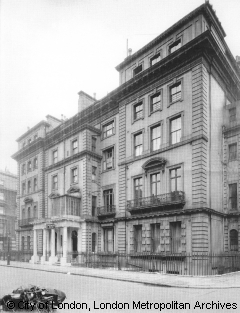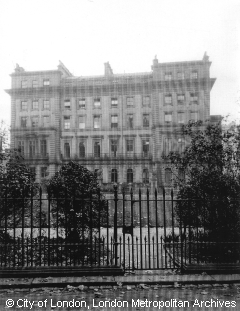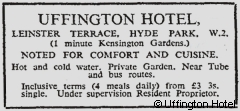Westminster Council approved the planning applications
in May 1920. Separating walls were knocked through at
various floor levels and soon the Uffington Hotel was
open for business. It had over twenty bedrooms and could
accommodate about 45 guests. The Uffington Hotel
claimed to be "noted for comfort and cuisine" and
offered four meals daily from £3 3s, hot and cold water,
and a private garden - the same one Corringham still
enjoys today.
In 1931 the London Squares Preservation Act came into
force. The Craven family still owned the freehold of
Craven Hill Gardens. In 1933 Caryl Walter Craven, a
distant relative of William, 3rd Baron Craven, who had
originally acquired the land, signed an agreement with
the London County Council that the garden would be
preserved.
The leases for 13 Craven Hill Gardens and for the
Uffington Hotel at numbers 14-16 expired in 1939.
Perhaps that is why the hotel was requisitioned during
the Second World War to be used as a Civil Service
hostel. The London Bomb Damage Map of 1946 shows that
the hostel survived the bomb raids unscathed. Although,
according to a newspaper article in The Times of 1950,
the buildings "could be restored without undue
difficulty" to a private hotel, the same article reports
that hotelkeepers were not keen to invest.
Around this time the Craven family decided to sell the
freehold of the land on which Corringham now stands -
land that had been their property since 1733. The new
freeholder was a Ms Wimbush.
In 1951 Ms Wimbush let the properties to the London
Hostels Association. Westminster Council approved the
continued use of 14-16 Craven Hill Gardens as a hostel
for a limited period of 21 years. Number 13 was added
in 1951, and Dr Sinclair's former GP practice at number
16 was incorporated in 1952 - 1953.
Many modern blocks appeared in Bayswater in the early
1950s. Buildings damaged during the war were replaced,
and when in 1957 the Church Commissioners sold their
land in the area, property developers were keen to
invest. The Hallfield Estate was built as public housing
on an area badly damaged during the war. Its apartment
blocks and its widely praised school by Denys Lasdun
and Lindsey Drace in partnership with Tecton were an
attempt to realise Le Corbusier's idea of a city in a
park. Eastbourne Terrace was entirely rebuilt by C. H.
Elsom, whose office blocks of 1957-9 have been acclaimed
as "a gaunt bit of plain speaking", forming a sequence
as unified as that of the stuccoed ranges to the west.
In 1960 the freeholder of the Uffington Hotel decided
that she wanted to replace the old hostel with a modern
block of flats, which were to be let on 99-year leases.
Property developer Lionel Simmons of Hector Properties
Investments agreed with Ms Wimbush that he would
demolish the old buildings and construct "48 high class
residential maisonettes" on the same location. In August
1961 the Paddington Magazine reported that "demolition
work has started on 13-16 Craven Hill Gardens".


